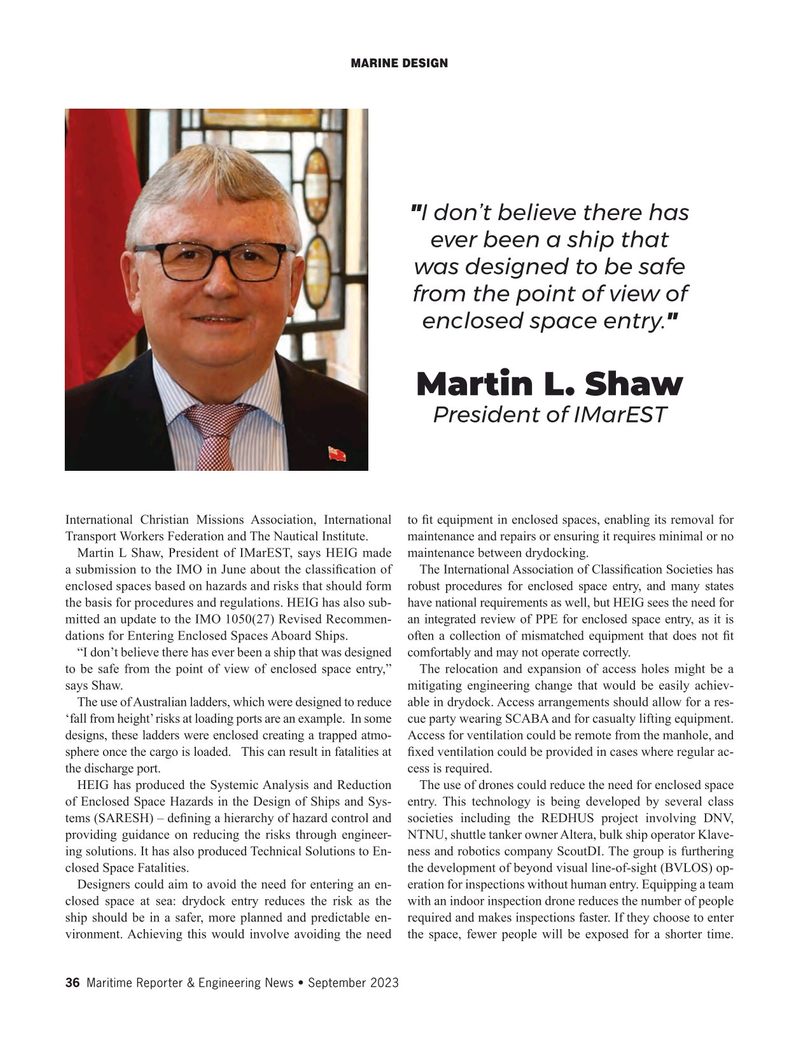
Page 36: of Maritime Reporter Magazine (September 2023)
Marine Design Edition
Read this page in Pdf, Flash or Html5 edition of September 2023 Maritime Reporter Magazine
MARINE DESIGN "I don’t believe there has ever been a ship that was designed to be safe from the point of view of enclosed space entry."
Martin L. Shaw
President of IMarEST
International Christian Missions Association, International to ? t equipment in enclosed spaces, enabling its removal for
Transport Workers Federation and The Nautical Institute. maintenance and repairs or ensuring it requires minimal or no
Martin L Shaw, President of IMarEST, says HEIG made maintenance between drydocking.
a submission to the IMO in June about the classi? cation of The International Association of Classi? cation Societies has enclosed spaces based on hazards and risks that should form robust procedures for enclosed space entry, and many states the basis for procedures and regulations. HEIG has also sub- have national requirements as well, but HEIG sees the need for mitted an update to the IMO 1050(27) Revised Recommen- an integrated review of PPE for enclosed space entry, as it is dations for Entering Enclosed Spaces Aboard Ships. often a collection of mismatched equipment that does not ? t “I don’t believe there has ever been a ship that was designed comfortably and may not operate correctly.
to be safe from the point of view of enclosed space entry,” The relocation and expansion of access holes might be a says Shaw. mitigating engineering change that would be easily achiev-
The use of Australian ladders, which were designed to reduce able in drydock. Access arrangements should allow for a res- ‘fall from height’ risks at loading ports are an example. In some cue party wearing SCABA and for casualty lifting equipment. designs, these ladders were enclosed creating a trapped atmo- Access for ventilation could be remote from the manhole, and sphere once the cargo is loaded. This can result in fatalities at ? xed ventilation could be provided in cases where regular ac- the discharge port. cess is required.
HEIG has produced the Systemic Analysis and Reduction The use of drones could reduce the need for enclosed space of Enclosed Space Hazards in the Design of Ships and Sys- entry. This technology is being developed by several class tems (SARESH) – de? ning a hierarchy of hazard control and societies including the REDHUS project involving DNV, providing guidance on reducing the risks through engineer- NTNU, shuttle tanker owner Altera, bulk ship operator Klave- ing solutions. It has also produced Technical Solutions to En- ness and robotics company ScoutDI. The group is furthering closed Space Fatalities. the development of beyond visual line-of-sight (BVLOS) op-
Designers could aim to avoid the need for entering an en- eration for inspections without human entry. Equipping a team closed space at sea: drydock entry reduces the risk as the with an indoor inspection drone reduces the number of people ship should be in a safer, more planned and predictable en- required and makes inspections faster. If they choose to enter vironment. Achieving this would involve avoiding the need the space, fewer people will be exposed for a shorter time. 36 Maritime Reporter & Engineering News • September 2023
MR #9 (34-49).indd 36 9/6/2023 4:43:41 PM

 35
35

 37
37
